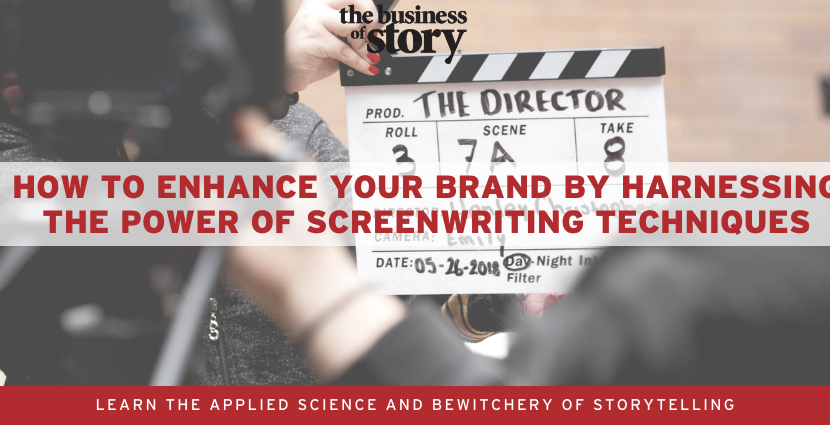In this post, I’d like to talk about how you can use movies — specifically the protagonist’s journey through the movie — as a guide to enhancing your brand and gaining more customers.
What does this mean exactly?
Well, it means tapping into the same innate and powerful storytelling techniques used by screenwriters to help potential clients better connect with what you have to say.
Once you’re able to connect with potential customers through utilizing yours and your customers’ stories, you’ll be that much more likely to get them on board with whatever it is you’re offering.
Firstly, I’m going to discuss how to master story by unlocking the secrets behind the protagonist’s journey through a movie.
Then I’m going to show you how you can apply the story lessons learned from this journey to your own website copy and ads in order to get others to identify more with your brand and enhance sales.
The Movie Protagonist’s Problem and Goal
It doesn’t matter what genre — Comedy, Drama, Action/Adventure, Thriller or Horror — all movie protagonists have the same thing in common: they all have a problem and a goal to achieve in order to rectify this problem. This goal forms the basis of the movie’s core conflict as we then struggle to achieve it against the odds.
- In There’s Something About Mary, Ted’s problem is that he’s still in love with Maryland so his goal is to be with her
- In The Truman Show, Truman’s problem is that he knows his life’s a TV show and so he wants to escape
- In Raiders of the Lost Ark, Indiana Jones’ problem is that the Nazis are after the all-powerful Ark and so he wants to get it first
- In The Silence of the Lambs, Clarice’s problem is that the serial killer Buffalo Bill is on the loose and so she wants to use Hannibal Lecter to catch him
- In The Blair Witch Project, Heather’s problem is that she and her colleagues are lost in the woods and being threatened by the witch and so she wants to escape
In this post, I will stick to Comedy examples as they’re the easiest to break down and explain the protagonist’s journey because nine times out of ten they have a happy ending.
 Horrors and Thrillers often end badly for the protagonist and there’s a whole other set of rules going on there that aren’t relevant to this discussion.
Horrors and Thrillers often end badly for the protagonist and there’s a whole other set of rules going on there that aren’t relevant to this discussion.
So, let’s take a few protagonists from well-known comedy movies: Annie from Bridesmaids, John from Ted, and Miles from Sideways. Again, each of these characters has a clear goal:
- Annie’s problem is that she’s a bit of a loser and now must be a successful Maid of Honor to her best friend, Lillian
- John’s problem is that he’s still a big kid inside and so wants to hang out with his slacker best friend, a talking teddy bear
- Miles’ problem is that he still hasn’t gotten over his ex and so wants to relax, play golf and drink wine instead of meet someone new
The Antagonist Who Gets In The Way Of The Protagonist’s Goal
In each case, though, there’s an antagonist who stands in the way of the protagonist achieving this goal because they want the exact opposite, and this is what causes the movie’s conflict:
- Lillian’s other friend, Helen, wants to out-do Annie as Maid of Honor
- John’s girlfriend, Lori, wants him to grow up
- Miles’ buddy, Jack, wants him to move on from his ex and get together with Maya
The Big Thing At Stake In This Protagonist vs. Antagonist Battle
Finally, there’s always something big at stake in this battle between the protagonist and antagonist’s goals.
These high stakes are what make us care whether the protagonist succeeds or fails. In Comedies, the stakes always revolve around the figurative “death” of the protagonist (as opposed to their literal death in a Thriller or Horror).
In other words, while following their journey we’re fearful that they may lose something of themselves and “die inside” if they don’t achieve their goal.
- If Annie messes up Lillian’s wedding she may not only lose a friendship but also slip further down into depression at the state of her life
- If John doesn’t grow up he will lose Lori and therefore the person he’s meant to be with
- If Miles doesn’t get together with Maya he will lose the person who could get his life back on track
These are the three basic building blocks of what constitutes the protagonist’s journey through a movie and it’s overall core conflict: a protagonist with a problem, the goal with high stakes attached and opposition to that goal from a strong antagonist who wants the opposite outcome.
The Protagonist’s Resulting Change
The first time will show you what the protagonist thinks they want because they’re at this point still flawed individuals who need to grow:
- At the start of Bridesmaids, Annie thinks she wants a sleazebag and to not be Maid of Honor
- At the start of Ted, John thinks he wants to live a life of hedonism with Ted
- At the start of Sideways, Miles thinks he wants to get back with his ex rather than pursue a new relationship with Maya
However, during the course of the movie and through their contact with the antagonist, they learn what’s truly at stake in their life and what they will lose if they don’t change. In other words, they learn to overcome their flaw and go and get what they need rather than what they thought they wanted.
- At the end of Bridesmaids, Annie befriends Helen, makes up with her best friend the bride, and gets together with a nice guy
- At the end of Ted, John finally grows up and gets engaged to Lori, putting her before Ted
- At the end of Sideways, Miles accepts that his ex has moved on and drives back to wine country to go see Maya
The reason these journeys all follow similar paths is that this formula resonates so strongly with our unconscious mind that’s been hardwired by evolution to make sense of the world through story. This causes us to subconsciously put ourselves in the protagonist’s shoes while watching a movie and hence learn about ourselves as we watch them learn, grow and change.
How The Movie Protagonist’s Journey Can Help Enhance Your Brand
Once you understand how a movie protagonist changes as they move through the story, you’ll be better equipped to apply this technique to your own brand. The best way to do this is to reframe how you present yourself and what you’re selling.
Rather than simply listing the attributes of a particular product or service, you can add the protagonist’s journey and transformational change to your ad or website copy and so make it resonate that much more with the potential client or consumer.
Let’s say you want to create an About page for your website…
This would be a perfect opportunity to really grab the reader’s attention by not just telling them your background and how you set up your business, but structuring the content on the page using a movie protagonist’s journey.
The paradigm remember goes like this: a protagonist has a problem which leads to them having a goal to achieve with high stakes attached against the wishes of a strong antagonist who wants the opposite.
Let’s say you have a guitar tuition business. You want to stand out from all the other guitar instructors out there, both online and in your city. You want to start getting more clients through your free lessons on YouTube as well as from ads in your local store.
The traditional method of doing this would be to craft website copy and ads that talk about what you offer: your years of experience, your competitive rates, the fact you once supported Beck on tour, etc. What this method misses out on, though, is story: The relationship between our hardwired human predisposition to stories and our ability to connect with other people.
In this example, our guitarist could frame his About Me story like this:
- Protagonist’s problem: He’s stuck in a boring dead-end job
- Protagonist’s initial “want”: To quit his day job and join or found a successful band
- High stakes: If he doesn’t achieve this he will be destined to live an unfulfilled life
- Antagonist’s goal: His wife and kids need his support from a steady income
- Protagonist’s realization of their “need”: To gain joy from teaching music, rather than hanging on to the dream of being a rock star
If the guitarist in this example was to design an About page based on this conflict — how he went from aspiring rock star to happy teacher after facing certain obstacles and realizing what he needed rather than what he wanted — he would be creating a compelling story. This story is what would then draw in the reader and help them to connect with him and consequently be that much more likely to actually sign up for his lessons or purchase an online course.
Or let’s say you wanted to create some video ads…
Similarly, let’s say, Emily, the owner of a tech start-up wanted to create an ad for her consulting services.
Rather than go down the usual road of writing about how great her consulting is and what it can do for the client, she could create a series of two-minute videos showcasing former clients’ stories.
She could get each former client to talk about their own story — how they had a problem they wanted to solve, what stood in their way, what was at stake if they didn’t solve it and so on.
Each video would then connect with prospective clients on a gut level as they’d be able to recognize themselves in each story — in much the same way as we live vicariously through a protagonist’s journey in a movie.
Conclusion: Harness The Power of Storytelling to Win More Business
In today’s rapidly changing and increasingly competitive marketplace it’s so important to be able to harness the power of storytelling in order to help customers and clients be able to embrace your brand and what you can do for them. Countless business leaders and entrepreneurs now utilize the power of story found in movies as a way of doing this and increasing their profits, so maybe now might be a good time to join them?
The best way to really get a handle on how this paradigm works is to apply it to any movie you watch. Simply make a mental note the next time you see a film of who the protagonist is, what they want, who is standing in their way from getting it, and what’s at stake if they don’t. This will require stepping back from the passive experience of watching movies and thinking about them from the perspective of the protagonist’s journey from the first time you see them to the last.
There are also many books on screenwriting that discuss this innate connection between a movie protagonist’s journey and all forms of story, from ancient myths, to Shakespeare to video games. Three of my personal favorites are and I highly recommend them all if you want to go deeper in your research:
- The Hero’s Journey by Joseph Campbell
- Inside Story by Dara Marks
- Into The Woods by John Yorke
Alex Bloom is the founder of Script Reader Pro — one of the few screenplay consultancies made up of working Hollywood screenwriters. If you’re a budding screenwriting, learn more about their script coverage services and follow them on Twitter @ScriptReaderPro.










